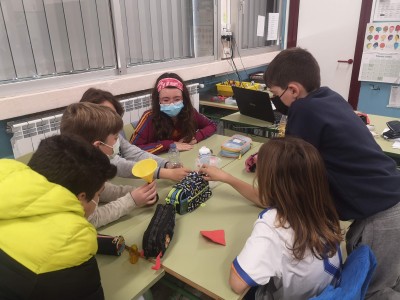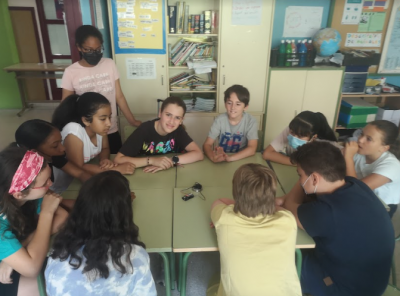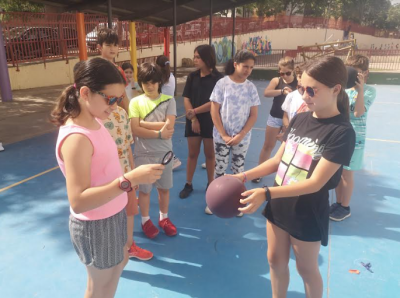
Make an OBSERVATION We observe that the balloon is filled with gas. Observamos que el globo se llena de gas. Ask a QUESTION Can we demonstrate inside the balloon there is gas? Can we pour the gas in a jar and use it to put out a candle? ¿Podemos demostrar que dentro del globo hay gas? ¿Podemos verter el gas en una jarra y usarlo para apagar la vela? Make a HYPOTHESIS We can put down the fire using the gas because it is CO2 and this gas does not allow the fire to be on. Sí podremos apagar el fuego usando el gas porque es CO2 y este gas no permite que el fuego que siga encendido. We can’t pour the gas into the jar because it will escape. No podremos echar el gas en la jarra porque se escapará. We can’t put out the candle using the gas because when you try to put the gas on the candle the gas goes around the room. No podremos apagar la vela usando el gas porque cuando tratemos de echar el gas en la vela el gas se esparcirá por la clase. We can’t put out the fire using the gas because I think the balloon will explode before. No podremos apagar la vela porque el globo con el gas explotará antes. Conduct your EXPERIMENT Materials A candle A lighter A jar Vinegar Bicarbonate of soda A balloon A funnel Procedure 1.Measure 100 millilitres of vinegar with the jar and put it in a bottle. Mide 100 ml de vinagre con una jarra y échalo en una botella. 2. Place a spoonful of bicarbonate of soda in the balloon. Pon una cucharada de bicarbonato en el globo. 3.Place the opening of the balloon around the neck of the bottle, Coloca la boca del globo alrededor de la boca de la botella. 4. Lift up the balloon and allow the bicarbonate to fall into the bottle. Eleva el globo y deja que caiga el bicarbonato en la botella. Report your RESULTS The balloon inflates very quickly. We pour the gas on the candle and …¡The candle goes out! El globo se infla muy rápido. Echamos el gas encima de la vela y…. ¡La vela se apaga! Draw CONCLUSIONS My hypothesis was correct/incorrect. The gas stays inside the jar and we can pour it on the candle in order to put it out. Mi hipótesis es correcta/incorrecta. El gas se queda dentro de la jarra y lo podemos verter encima de la vela para apagarla.

We have observed a compass pointing to the North. Observamos que la brújula siempre señala el norte. Can we change its direction? ¿Podemos cambiar su dirección? 2.CAn we make the same without using a magnet? 1.No, because a compass always points to the North because the Earth has magnetism. No, porque una brújula siempre señala el norte porque la tierra tiene magnetismo. 1. Yes, we can change its direction using a magnet. Sí,podemos cambiar su dirección usando un imán. ___________________________________________________ 2. No, we can’t change the the direction of the compass without a magnet. 2. No podemos cambiar la dirección de la brújula si no usamos un imán. Materials 4.5 V battery Electric wires (1) Crocodile clips A coil (bobina eléctrica) A magnet Procedure Wire 1: Place one extreme of a wire to the battery. Coloca un extremo del cable en la pila. Connect the other extreme to the other part of the battery. Conecta el otro extremo del cable en la pila. Place the wire on the compass. Pon la bobina de cable encima de la brújula. Observe The compass doesn’t point to North. La brújula no señala el norte. We have created a magnetic field. So the magnet of the compass doesn’t know where to point because there are two magnetic fields next to it. The compass becomes “crazy”. Hemos creado un campo magnético asi que, la brújula no sabe donde señalar ya que tiene dos campos magnéticos cerca. El de la Tierra y el electroimán. La brújula se vuelve loca.

SCIENTIFIC METHOD EXPERIMENT: The mystery of the bursting balloons Make an OBSERVATION When we are dressed in black and it's very sunny we are very hot, but if we are dressed in white we are better. Ask a QUESTION Can we demonstrate dark colours absorb the heat better? Make a HYPOTHESIS Yes, we can demonstrate it using balloons and a magnificent glass. No, we can't, because we can’t measure the temperature of colours. Conduct your EXPERIMENT Materials Different colours balloons. A magnificent glass. Sun glasses Procedure Inflate the balloons. Wear sunglasses. Place the magnificent glass between the balloon and the sun. Control the time until the balloon explodes. Compare the different times obtained by different colours. Report your RESULTS Light balloons took more time to explode, while the darker is the colour the less time it needs to explode. Draw CONCLUSIONS We have demonstrated that dark colours absorb more energy (heat) than light colours because they don’t reflect any light, so they keep all the energy. That makes dark balloons explode before light balloons.